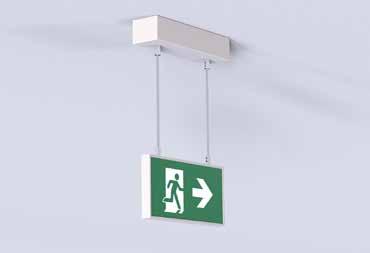
2 minute read
Emergency Lighting meets sustainability
In 2021 the UK government set the world’s most ambitious carbon reduction plan, to reduce carbon emissions by 78% by the year 2035. Buildings contribute greatly to UK carbon emissions therefore building owners, designers, maintenance professionals and installers are seeking practical ways to reduce operational and embodied carbon emissions and emergency lighting can contribute toward net zero.
The Leading global sustainability experts AECOM, recently conducted a carbon study on the use of emergency lighting products in buildings, we asked “What impact would result in using the latest technologies within a building’s carbon footprint?”
The AECOM study compared a typical installation of 1000 self-contained emergency light fittings with various battery technology and testing systems.
The battery technology included:
NiCd, NiMH and L10 Lithium
Nanophosphate
The testing Systems included: Manual test, DALI, RF and Zoneworks
XT HIVE
The assessment focuses on the “differences” in the carbon impact of the diferent combinations of battery and testing systems used to provide an overall carbon impact scenario Key measures in the assesment included:
• Operational Energy Consumption
• Fittings Replacement
• Driving for testing and maintenance
• Original and replacement batteries
• Waste Disposal
• Extra hardware and components.
The study made some key findings:
L 10 Nanophosphate and Zoneworks XT Hive can reduce carbon emissions by up to 89%.
L10 Nanophosphate alone has a lower carbon footprint in comparison to Ni-Cd/Ni-MH and other Lithium chemistry batteries which require on average between 4-6 cells to achieve the same result.
Per single battery, the NiCd/NiMH battery has an embodied carbon impact around 1.5 times greater than L10 Nanophosphate.
• L10 Nanophosphate with a 12 year design life last 3 times longer than NiCd and NiMH alternatives.
• Additional hardware and cabling for wired DALI systems increases the carbon output by 45t CO2e for a 1,000 fitting installation compared to Zoneworks HIVE
The findings are clear, Clevertronics products and solutions were found to give considerable carbon reduction benefits compared to other conventional emergency lighting systems on the market

Five key stages were considered in the life-cycle of an emergency lighting installation for the report
The raw materials needed to produce the products

The disposal and recycling of the products at end of life
The manufacturing process
The overall use of the product
The distribution of the products
As AECOM says, “Clevertronics Zoneworks XT Hive combined with L10 batteries present a carbon saving of up to 89% when compared to other popular systems and Ni-Cd/Ni-MH battery equivalents.”
‘Dependant on the comparative system and number of batteries per fitting, the Hive system (combined with L10 battery technology) presents a carbon saving of 28-89%’ (based on selected variables considered within the assessment).

The following case study represents an installation of 1,000 emergency light fittings using typical systems and technologies that are available in the market today and considers the full product lifecycle over a 12-year lifetime.


Why 12 years? That’s the design life of L10 fittings. The results support that when topics such as carbon neutrality or carbon reduction are in discussion Clevertronics fittings and systems should be your number one specification option. There is no better emergency lighting solution that supports carbon reduction plans.



